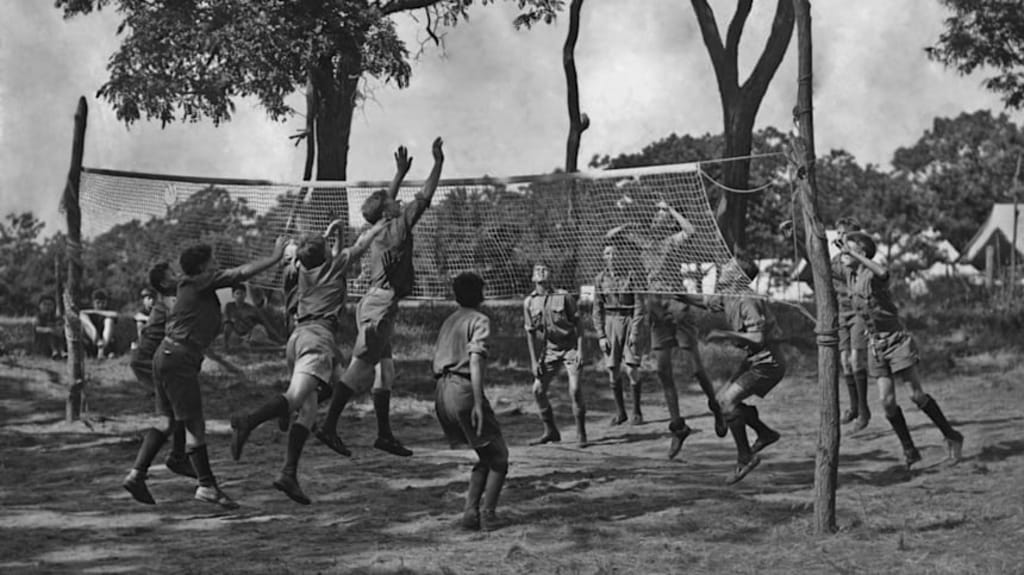History of volleyball: From humble beginnings to a global sport
History of volleyball

Volleyball, a fast-paced and exciting team sport, has a rich history that spans over a century. From its humble beginnings to becoming a global phenomenon, volleyball has captured the hearts of millions of players and fans worldwide. In this essay, we will explore the fascinating journey of volleyball, tracing its origins, key milestones, and its rise to becoming a popular sport on a global scale.
The origins of volleyball can be traced back to the late 19th century. In 1895, William G. Morgan, a physical education director at the YMCA in Holyoke, Massachusetts, sought to create a new indoor game that combined elements of basketball, tennis, handball, and baseball. Morgan aimed to develop a game that was less physically demanding than basketball but still required skill and teamwork. He called this new game "mintonette."
The first game of mintonette was played on July 7, 1896, at the YMCA in Holyoke. The sport quickly gained popularity within the YMCA community, and its rules were refined over time. One significant change was made when a spectator observed that the players were volleying the ball back and forth over the net. Inspired by this observation, the name of the game was changed to "volleyball" in 1896.
The game's popularity continued to grow, particularly within the United States. In 1900, the first official rules of volleyball were published by the YMCA, and the game spread to various colleges and universities across the country. Volleyball was introduced to international audiences in 1913 when the game was demonstrated at the Far Eastern Games in Manila, Philippines. The demonstration sparked interest and helped establish volleyball as an international sport.
In 1947, the Fédération Internationale de Volleyball (FIVB) was founded in Paris, France, as the international governing body for volleyball. This milestone marked a turning point in the sport's history as it laid the foundation for international competitions and standardization of rules. The FIVB continues to oversee the development and promotion of volleyball globally.
The first official international volleyball tournament took place in 1949, with the establishment of the Pan-American Games. The sport made its Olympic debut at the 1964 Tokyo Olympics, and volleyball's inclusion in the Olympics played a crucial role in its global recognition and popularity. Since then, volleyball has been a staple of the Summer Olympics, captivating audiences with its fast-paced action and intense competition.
In addition to indoor volleyball, the sport also developed a beach variant. Beach volleyball originated in Santa Monica, California, in the 1920s, where it was played recreationally on the beaches. It gained widespread popularity in the 1980s when professional tournaments were organized, and the first FIVB Beach Volleyball World Championships were held in 1997. Beach volleyball's unique atmosphere and dynamic gameplay have contributed significantly to the sport's global appeal.
Over the years, volleyball has witnessed various innovations and advancements. One notable development was the introduction of rally scoring in 1999, which allowed teams to score points regardless of who served. This modification added to the intensity and excitement of the game.
Volleyball's global reach and popularity have expanded significantly. The FIVB has played a crucial role in promoting the sport and organizing major international events. Today, volleyball is played in over 220 countries, with millions of participants and a massive fan base. The FIVB World Championships, World Cup, and World Grand Prix are among the most prestigious international tournaments that draw top teams and players from around the world.
The sport's growth and popularity have also been bolstered by technological advancements. Television and the internet have brought volleyball into the homes of millions of fans, allowing them to follow their favorite teams and players. The increased exposure has helped
"In search of an appropriate game, tennis occurred to me, but this required rackets, balls, a net and other equipment, so it was eliminated, but the idea of a net seemed a good one," Morgan explained. "We raised [the net] to a height of... just above the head of an average man. We needed a ball and among those we tried was a basketball bladder, but this was too light and too slow. We therefore tried the basketball itself, which was too big and too heavy.”
A new specially designed ball, which was lighter and smaller, was introduced in 1900.
Though it was incomplete with no fixed rules and a format to follow, the sport did enough to win over the delegation and soon became a part of YMCA’s wide network throughout the USA with a new name - volley ball (initially it was termed as two words). Volleyball was officially selected to spell as a single word in 1952.
A sport that traced its origin to basketball, baseball, tennis and handball - and now estimated to be played by over 800 million globally - had thus been established.
About the Creator
Enjoyed the story? Support the Creator.
Subscribe for free to receive all their stories in your feed. You could also pledge your support or give them a one-off tip, letting them know you appreciate their work.





Comments
There are no comments for this story
Be the first to respond and start the conversation.